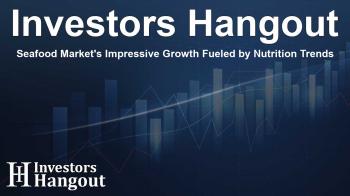Seafood Market's Impressive Growth Fueled by Nutrition Trends

Global Seafood Market Growth Overview
The global seafood market is set to experience considerable expansion in the coming years, with a projected increase of approximately USD 150.04 billion from 2024 to 2028. This growth is being significantly influenced by the rising consumer awareness surrounding healthy nutrition. The compound annual growth rate (CAGR) during this forecast period is estimated to be around 13.55%, which underscores the positive momentum in this sector. Factors such as health consciousness and improvements in technology supported by artificial intelligence are shaping the market's future.
Driving Factors Behind Market Growth
One of the major catalysts for the seafood market’s growth is the increasing global awareness of the nutritional benefits seafood provides. Seafood is recognized as a primary source of protein, essential vitamins, and minerals. Consumers are leaning towards healthier eating habits, and incorporating lean seafood options like cod, tilapia, and fatty fishes such as salmon and tuna into their diets promotes overall well-being.
Focus on Sustainable Practices
As sustainability has become a pressing concern for consumers, the seafood industry is taking steps to ensure responsible fishing practices. Certifications from reputable organizations, like the Marine Stewardship Council and the Aquaculture Stewardship Council, help consumers make informed choices that align with their values. Technologies such as 3D printing and culinary innovation enable businesses to create new, exciting seafood products, capturing the interest of health-conscious diners and adventurous eaters alike.
Emergence of E-Commerce in Seafood Distribution
The rise of e-commerce has transformed how seafood is sold. With more consumers preferring to shop online, especially post-pandemic, seafood suppliers are seizing the opportunity to populate online marketplaces. In the United States, online sales accounted for a significant portion of total retail sales, suggesting a shift in consumer buying habits. This transition allows seafood manufacturers to broaden their reach and enhance customer engagement.
Technological Advancements and Consumer Interaction
Technological advancements are driving innovation in the seafood sector, from production methods to how businesses interact with consumers. The convenience of online shopping and personalized marketing campaigns fosters a stronger connection with consumers. By tapping into user data, companies can tailor their offerings to meet specific needs, further solidifying their customer base.
Challenges Facing the Seafood Industry
Despite the optimistic outlook for the seafood market, several challenges persist. Price volatility remains a critical issue, with fluctuations affecting profitability. Furthermore, overfishing poses a considerable threat to fish stocks and entire ecosystems. Finding a balance between catering to demand and ensuring sustainability is crucial, and industry players are collaborating with regulatory bodies to maintain healthy fish populations.
Impact of Environmental Regulations
Regulations concerning seafood quality and sourcing have ramped up, compelling businesses to adopt sustainable practices. The push for transparency, traceability, and responsible sourcing of seafood is more significant than ever. Companies are increasingly expected to prove that their products are free from toxins and environmentally harmful practices.
Market Segmentation Insights
The seafood market can be segmented in various ways, helping stakeholders understand consumer preferences better. Key classifications include:
- Type (Fish, Crustaceans, Mollusca, Others)
- Distribution Channel (Online, Offline)
- Geographic Regions (APAC, North America, South America, Europe, Middle East, and Africa)
- Form (Fresh, Processed)
The Future of the Seafood Market
The future of the seafood market looks promising, characterized by a blend of tradition and innovation. Continued focus on health benefits, sustainability, and consumer preferences will shape market strategies. Companies capable of adapting and responding to changes in consumer behavior will thrive during this evolution. Exciting times lie ahead for the seafood industry as it forges a path toward enhanced market dynamics driven by technological advancements and a greater emphasis on health.
Frequently Asked Questions
1. What is the projected growth of the seafood market?
The seafood market is expected to grow by USD 150.04 billion from 2024 to 2028.
2. What factors are driving the growth in seafood consumption?
Rising consumer awareness of the health benefits of seafood and the convenience of online shopping are major driving factors.
3. How is sustainability impacting the seafood industry?
Sustainability initiatives and certifications are enhancing consumer trust and encouraging responsible consumption and sourcing of seafood.
4. What challenges does the seafood market face?
Challenges include price volatility, overfishing, and the need to comply with stringent regulations regarding quality and sustainability.
5. How is e-commerce shaping the seafood industry?
The rise of e-commerce is providing seafood suppliers new avenues for market expansion and consumer engagement, significantly altering distribution channels.
About The Author
Contact Olivia Taylor privately here. Or send an email with ATTN: Olivia Taylor as the subject to contact@investorshangout.com.
About Investors Hangout
Investors Hangout is a leading online stock forum for financial discussion and learning, offering a wide range of free tools and resources. It draws in traders of all levels, who exchange market knowledge, investigate trading tactics, and keep an eye on industry developments in real time. Featuring financial articles, stock message boards, quotes, charts, company profiles, and live news updates. Through cooperative learning and a wealth of informational resources, it helps users from novices creating their first portfolios to experts honing their techniques. Join Investors Hangout today: https://investorshangout.com/
The content of this article is based on factual, publicly available information and does not represent legal, financial, or investment advice. Investors Hangout does not offer financial advice, and the author is not a licensed financial advisor. Consult a qualified advisor before making any financial or investment decisions based on this article. This article should not be considered advice to purchase, sell, or hold any securities or other investments. If any of the material provided here is inaccurate, please contact us for corrections.

